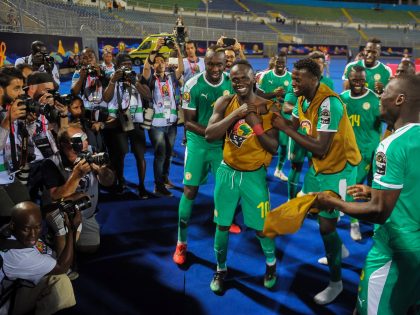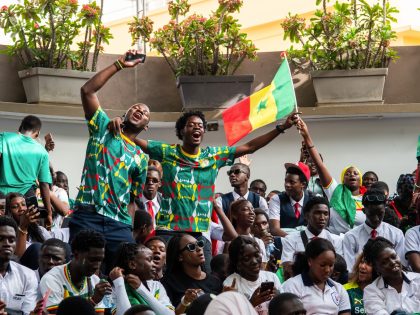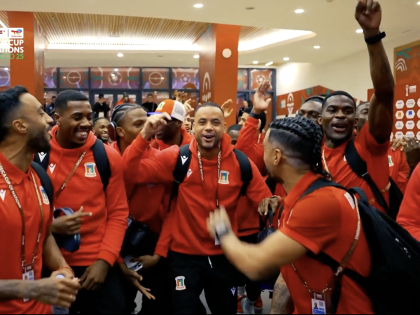Do critiques of representation make a real difference?
The Rusty Radiator Awards is not a critique of existing power relations and stark global inequalities, but of representation.

Still from one of SAIH's video campaigns.
At the beginning of December 2014, Norwegian NGO SAIH – The Norwegian Students and Academics International Assistance Fund – announced the winners of its second annual Rusty Radiator Awards at an official ceremony in Oslo. SAIH advocates for a complex understanding of injustice and to fight against the ‘[l]ack of knowledge and bad consciousness’, which they see as reasons for the common belief ‘in simple solutions when confronted with an unjust world’.
2014’s Rusty Radiator Awards follow SAIH’s success with the clips “Radi-Aid: Africa for Norway” and “Let’s save Africa! – gone wrong” as well as the 2013 Rusty Radiator Awards. (For a critique of the first campaign, see David Jefferess’ article as well as a blog post on the site of the organization I work for in Berlin; for a critique of the second, see here).
The Awards appear successful in sparking a dialogue about how aid communication can be less racist and stereotypical, but regarding SAIH’s goal to portray global (and local) injustice in a more complex manner: the Awards fall short.
Let’s have a look at the two videos nominated by an international jury and considered the best and the worst by the voters of 2014’s Radiator Award. The South African charity Feed a Child was awarded as the ‘charity producing the most clichéd and unhelpful fundraising video’. Here’s the video:
The video shows a wealthy white woman treating a Black child like a dog, and the boy behaving just like a well-behaved dog that likes its owner. In the epilogue of the video, we read: ‘The average domestic dog eats better than millions of children.” The Rusty Radiator Award Jury’s comment was as follows:
Completely “White Saviour”. David had to turn it off after 10 seconds. Racism isn’t something of 200 years back, it’s something very present in South Africa today. […] The message doesn’t justify using the same stereotypes to both raise awareness and steal agency. The poor are already depicted as incapable of their own rescue, now they are being compared to dogs.
There was a big debate around the video in South Africa when it first came out (see here, here and here) and it was eventually withdrawn by the charity (who sort of apologized for it).
It is indeed painful to watch this violent and racist clip. Yet, while it portrays children and Black people as without agency, it unintentionally provides a damning critique of both the aid industry as well as post-Apartheid South Africa. While the inequality of the relationship between the Black child and white adult is crystal clear, it is portrayed as devoid of explicit (physical or verbal) violence. Both parties seem to be perfectly fine with the way things are. However, it can also be read as offering a metaphor for what life is like in South Africa for the majority of people: that the dogs of rich people actually do eat better than millions of (mainly Black) children. By completely exaggerating the relationship between ‘donor’ and ‘recipient’, it constitutes a pertinent critique of welfare as well as development aid practices. Contextualized in South Africa’s recent history, it goes beyond a metaphorical statement: non-white South Africans had to serve their white masters and mistresses like dogs. However, with this is a wishful reading of the ad: we are aware that Feed a Child’s intention was neither an anti-racist, anti-capitalist critique of present-day South Africa nor an attack on charity work as such. Instead, the video appeals to the viewers: ‘Help feed a starving child. SMS ‘child’ to 40014 to donate R20’.
Save the Children UK’s ‘Most Shocking Second a Day Video’ was awarded the Golden Radiator Award ‘which goes to the charity offering the most innovative and empowering vision’. Here’s the video:
The goal of the video is to raise awareness and money for children in Syria; it shows a young girl in different everyday situations at the beginning, but halfway through the clip the fear and violence of war enters the scene. The Jury argued for the quality of this clip as follows:
Any advocacy ad that can put you in the middle of the situation instead of casting people and situations you’d never imagine is a good one. […] You feel for the little girl as if she was someone you knew next door or your children went to school with. It emphasises the universality of suffering and empathy, and breaks racial stereotypes about who suffers.
The makers of the clip portray the UK as a place of happiness and light-heartedness; the war scenes are surprising and out of place. This is achieved through various means: The settings the girl appears in (practicing the flute, being pinched by ‘granny’, school uniform etc.) and the evident British accent. Here, the issue of racialised bodies is noteworthy: a child with blue eyes and light skin was chosen. We wonder whether it would have worked as well had the child been black or worn a headscarf. This brings us to the question of whether the makers of the ad (as well as the jury and voters of the Golden Radiator Award) had in mind that many young non-white and poor people in the UK actually grow up in conditions of violence and constant insecurity. Street violence in deprived neighbourhoods comes to mind, but also racist policing: black people are up to 28 times more likely to be stopped and searched than white people.
Vanessa de Oliveira Andreotti’s points out ‘if we want to work towards ideals of justice, we need to understand better the social and historical forces that connect us to each other’. In the clip we cannot identify any hints of relationality. While the South African ad may be interpreted as – albeit unintentionally – portraying poverty and wealth, humiliation and exploitation as related, the UK one does not tell us who is responsible for the suffering of the child or who profits from it. Here, we could ask who is providing the weapons for the Syrian war and who has supported the Assad regime for years and years. The UK is one of the world’s top five arms exporters and the current government continues to grant licences to Syria for dual-use chemicals that could be used in the manufacture of chemical weapons. This would also bring up de Oliveira Andreotti’s question, how the consumers of advertising would react ‘if they realized that bringing justice to others meant going against [one’s own] national/local interests.’ Would the people that Save the Children addresses as potential donors also contribute if a clip moved beyond a humanitarian relation and problematised the relationship of wars abroad with the UK’s industrial-military complex?
SAIH’s work is laudable in that it constitutes Western auto-critique for which satire is a very useful tool. It has managed to put the issue of stereotypes of the global South on the agenda in development aid circles, as well as the general public in the global North. But while the portrayal of people and societies in the Global South is questioned by the Rusty and Golden Radiator Awards, the assumption remains untouched that it is these people and societies that have deficits and have to change.
SAIH makes clear that they do not really want to move beyond the dominant structures: ‘We, as a development organization, are not opposed to development aid’. Indeed, none of the clips asks us to question relations of power or to politically engage in transformative endeavors. The subtexts of both ‘good’ and ‘bad’ clips thus remains the same. The Awards make us believe that it is possible to produce non-racist, non-discriminatory advertising in a policy field so deeply entrenched in the history and present of global colonial racism – you just have to be clever and creative. However, if we merely criticize development aid for using stereotypes, we fail to understand the connection between the concept as well as practice of development and the legacy of colonialism and racism. The Awards thus run the danger of stabilizing the underlying structural violence of relations between the global North and South, between poor and rich, by applauding cosmetic repairs of the surface.
This year’s awards were accompanied by the video clip ‘Who wants to be a volunteer’, made in collaboration with the South Africa-based company iKind. The satirical film mocks Western stereotypes of Africa and brings up the issue of charity-mania. It holds the mirror up to the self-centeredness of Western volunteers (see the really great scene in which the volunteer takes a selfie) when engaging with what is commonly portrayed as altruistic. While at first glance one might have the impression that the clip also criticizes Western voluntourism in African countries as such, SAIH states that ‘[t]he video is not a critique of youth traveling to Africa to work as volunteers, but rather of the simplistic exotification of the continent that still dominates today’. Just like the Awards, it is not a critique of existing power relations and stark global inequalities, but of representation.
Yet tourism and its sub-form “voluntourism” from the global North to the global South are inevitably implicated in racialised cultural and economic exploitation of formerly colonised peoples. Of course, non-exoticising voluntourists and volunteers are nicer than overtly racist ones, but materially there is little difference as they are part of, and perpetuate, the existing unequal relations between global North and South. As much as we enjoy watching SAIH’s clips and sympathise with their attempts of changing the image of Africa and development, their critique does not go deep enough to address the quintessential questions of inequality and power in the North-South context.
- A longer version of this essay was published in Pambazuka News No. 707, 18.12.2014. Full disclosure: Africa is a Country’s Boima Tucker served on the 2014 and Caitlin Chandler on the 2013 Rusty Radiator Awards Jury.



















